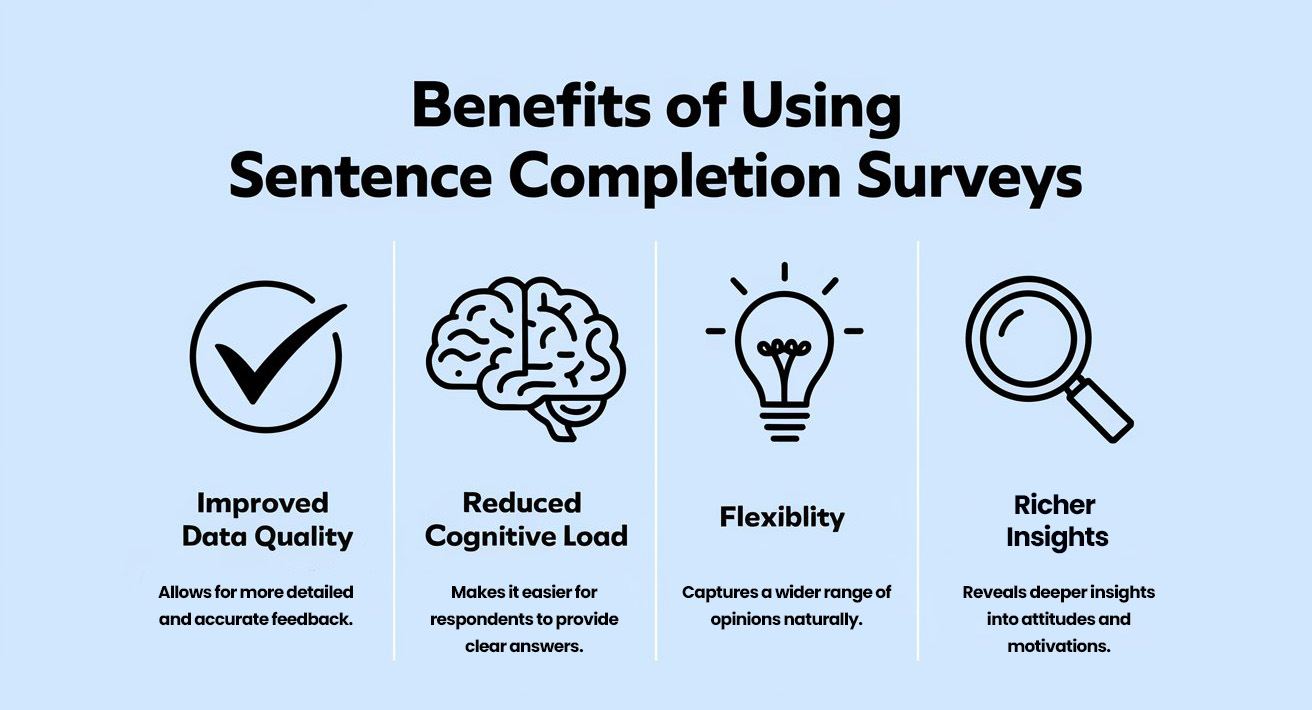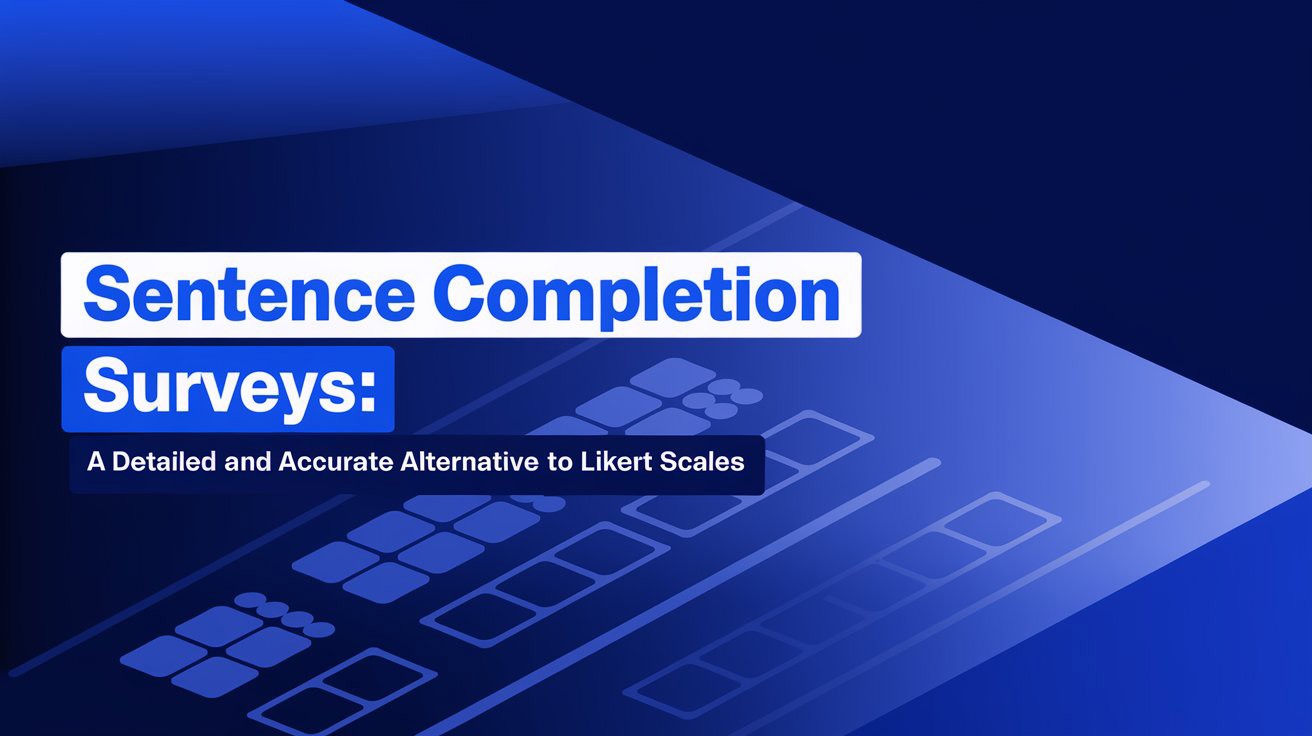When collecting data, researchers have traditionally relied on Likert scales to measure attitudes and opinions. While these scales are straightforward, they come with significant limitations, such as multidimensionality and rigid response categories, which can lead to cognitive overload for respondents and a loss of nuanced data.
According to a study by David R. Hodge and David Gillespie on ResearchGate, Likert scales often fail to capture the complexity of opinions because they require participants to simultaneously assess both content and intensity. This can result in oversimplified responses and a reduced quality of data.
An effective alternative is the sentence completion survey, also known as phrase completion.
This method allows respondents to provide more detailed and contextualized feedback, leading to higher-quality data.
Sentence completion surveys address the limitations of Likert scales by enabling participants to complete a sentence based on their thoughts, rather than choosing from pre-defined options. This approach captures richer insights and reduces cognitive strain.
The Problems with Likert Scales
Likert scales ask participants to choose between predefined categories, such as “Agree” or “Disagree.” While simple, this approach can introduce several challenges:
❌ Limitations of Likert Scales:
- Multidimensionality: Respondents must assess both the content and the intensity of their agreement or disagreement, leading to cognitive overload.
- Limited Insight: Likert scales often fail to capture subtle opinions. For instance, someone might “agree” with a statement but feel much more nuanced about the issue than a simple choice can represent.
- Negatively Worded Items: Including negatively worded items (e.g., “I am not happy with my job”) to balance the survey can confuse respondents, potentially skewing results.
According to David R. Hodge and David Gillespie (2003), Likert scales can lead to data loss, as they do not allow respondents to express the full scope of their opinions.
Respondents often feel limited in their choices, making it difficult to gather rich, detailed data.
Why Sentence Completion Surveys Are More Effective
Sentence completion surveys offer a way to solve these issues by providing a more open-ended approach. Instead of selecting from rigid categories, respondents are asked to finish a sentence in their own words, which encourages deeper reflection.
For example, instead of asking someone to rate the statement:
- “I enjoy my job.”
A sentence completion survey might prompt them with:
- “The most enjoyable part of my job is…”
✔️ Advantages of Sentence Completion Surveys:
- Reduces Cognitive Complexity: By focusing on a single aspect of their opinion, respondents can express themselves more clearly, without juggling multiple dimensions like they must with Likert scales.
- Offers Flexibility: Respondents are free to provide responses that truly represent their opinions, rather than being confined to specific categories.
- Captures Nuanced Data: Sentence completions give more room for complex answers, revealing deeper insights into attitudes and opinions.
Hodge and Gillespie’s research emphasizes that this method is not only easier for respondents but also produces higher quality data that more accurately reflects their thoughts.
How to Design Effective Sentence Completion Surveys
When designing a sentence completion survey, the goal is to create prompts that encourage open-ended responses. Here are a few guidelines:
Best Practices:
- Keep it Simple:
- ✔️Do: Use clear and straightforward language.
- ✘Don’t: Overcomplicate sentences with jargon or complex structures.
- Be Specific:
- ✔️Do: Focus on particular aspects to elicit detailed responses.
- ✘Don’t: Use vague prompts that may result in generic answers.
- Limit to One Topic per Sentence:
- ✔️Do: Ensure each prompt addresses a single concept.
- ✘Don’t: Combine multiple topics in one sentence, which can confuse respondents.
Examples of Effective Prompts:
- “The most important factor in customer service is…”
- “When I think about improving my skills, I usually…”
- “The biggest challenge I face in my role is…”
Sample Sentence Completion Survey
To better understand how a sentence completion survey works, let’s explore an example. This method gives respondents the freedom to complete sentences based on their own thoughts, allowing for more nuanced and detailed feedback.
Employee Satisfaction Survey
Benefits of Using Sentence Completion Surveys
Sentence completion surveys are more than just a method for gathering data—they offer several distinct advantages over traditional Likert scales.
Key Benefits:
- Improved Data Quality: The open-ended nature allows respondents to provide detailed and precise feedback, resulting in higher quality data that better captures their true opinions.
- Reduced Cognitive Load: By eliminating the need to assess both content and intensity, sentence completions make it easier for respondents to provide clear, thoughtful answers.
- Flexibility: Offers greater flexibility than Likert scales, capturing a wider range of opinions and enabling more natural responses.
- Richer Insights: Can reveal deeper insights into attitudes, behaviors, and motivations by allowing respondents to articulate their feelings in their own words.
This makes sentence completion surveys a powerful tool, especially in research fields where precise measurements are critical, such as psychology, education, and social sciences.

How to Get Started with Sentence Completion Surveys
Creating your own sentence completion survey is easier than you think. Here’s how to get started:
Steps to Create an Effective Survey:
- Define Your Objectives:
- ✔️Do: Clearly outline what you aim to discover.
- ✘Don’t: Proceed without a focused goal.
- Draft Clear Prompts:
- Use the best practices mentioned earlier to create effective sentence completions.
- Pilot Test Your Survey:
- ✔️Do: Test the survey with a small group to identify any issues.
- ✘Don’t: Skip testing, as this can lead to problematic data.
- Distribute and Collect Responses:
- Choose the appropriate channels to reach your target audience.
- Analyze the Data:
- Prepare for qualitative analysis to interpret open-ended responses.
Unlock the Power of Sentence Completion Surveys with Veeform
Creating your own sentence completion surveys is a breeze with Veeform!
Our user-friendly platform makes survey creation simple, allowing you to quickly gather valuable insights. Veeform’s intuitive interface also helps you analyze open-ended feedback, giving you deeper insights into your audience’s thoughts and behaviors.
Start creating surveys with Veeform FOR FREE today and unlock richer, more detailed data!
Conclusion
Sentence completion surveys offer a detailed and accurate alternative to traditional Likert scales. By allowing respondents to express themselves in their own words, these surveys:
- Capture Nuanced Opinions
- Reduce Cognitive Overload
- Improve Data Quality
- Provide Richer Insights
If you’re looking to gather more meaningful data that truly reflects your audience’s thoughts and feelings, consider implementing sentence completion surveys in your research.
FAQs
What are the key differences between sentence completion surveys and Likert scales?
Sentence completion surveys allow for open-ended, detailed responses, while Likert scales force respondents to choose from predefined categories. This makes sentence completions more flexible and capable of capturing nuanced opinions.
Do sentence completion surveys reduce response bias?
Yes, by avoiding rigid categories, sentence completion surveys allow respondents to express their thoughts freely, reducing bias and improving the accuracy of the data.
How can sentence completion surveys improve data quality?
By allowing respondents to complete sentences in their own words, this method provides deeper insights and reduces the cognitive load often associated with Likert scales.
Are sentence completion surveys harder to analyze?
They may require more qualitative analysis, but tools like VeeForm make it easy to collect and analyze open-ended responses.
Can sentence completion surveys be used in all types of research?
Absolutely! These surveys are particularly useful in fields like psychology, education, and market research, where nuanced data is crucial.

